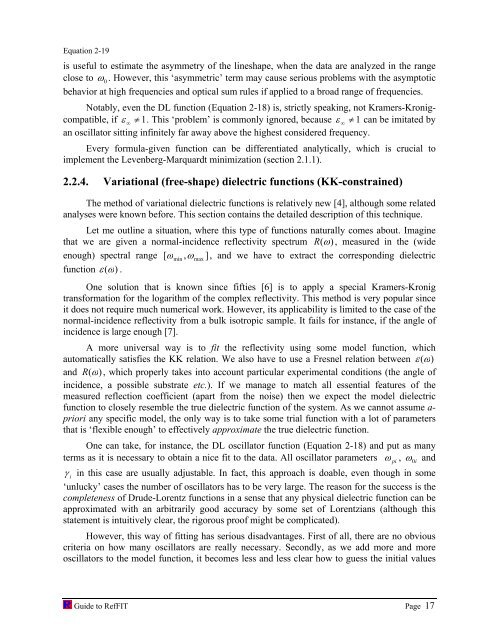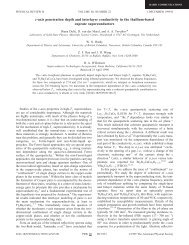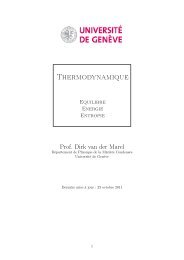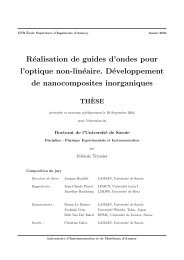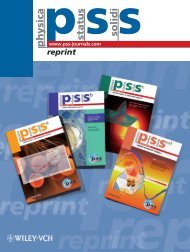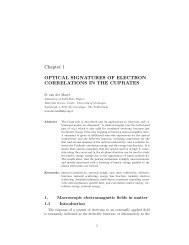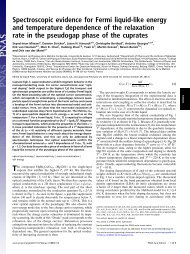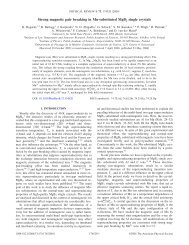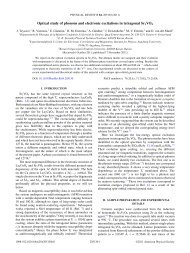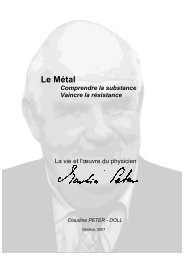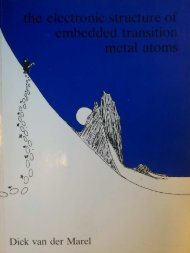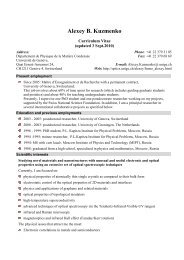software to fit optical spectra - Quantum Materials Group
software to fit optical spectra - Quantum Materials Group
software to fit optical spectra - Quantum Materials Group
Create successful ePaper yourself
Turn your PDF publications into a flip-book with our unique Google optimized e-Paper software.
Equation 2-19<br />
is useful <strong>to</strong> estimate the asymmetry of the lineshape, when the data are analyzed in the range<br />
close <strong>to</strong> ω 0 . However, this ‘asymmetric’ term may cause serious problems with the asymp<strong>to</strong>tic<br />
behavior at high frequencies and <strong>optical</strong> sum rules if applied <strong>to</strong> a broad range of frequencies.<br />
Notably, even the DL function (Equation 2-18) is, strictly speaking, not Kramers-Kronigcompatible,<br />
if ε ∞ ≠ 1.<br />
This ‘problem’ is commonly ignored, because ε ∞ ≠ 1 can be imitated by<br />
an oscilla<strong>to</strong>r sitting infinitely far away above the highest considered frequency.<br />
Every formula-given function can be differentiated analytically, which is crucial <strong>to</strong><br />
implement the Levenberg-Marquardt minimization (section 2.1.1).<br />
2.2.4. Variational (free-shape) dielectric functions (KK-constrained)<br />
The method of variational dielectric functions is relatively new [4], although some related<br />
analyses were known before. This section contains the detailed description of this technique.<br />
Let me outline a situation, where this type of functions naturally comes about. Imagine<br />
that we are given a normal-incidence reflectivity spectrum R (ω)<br />
, measured in the (wide<br />
enough) <strong>spectra</strong>l range [ ω min , ωmax<br />
] , and we have <strong>to</strong> extract the corresponding dielectric<br />
function ε (ω)<br />
.<br />
One solution that is known since fifties [6] is <strong>to</strong> apply a special Kramers-Kronig<br />
transformation for the logarithm of the complex reflectivity. This method is very popular since<br />
it does not require much numerical work. However, its applicability is limited <strong>to</strong> the case of the<br />
normal-incidence reflectivity from a bulk isotropic sample. It fails for instance, if the angle of<br />
incidence is large enough [7].<br />
A more universal way is <strong>to</strong> <strong>fit</strong> the reflectivity using some model function, which<br />
au<strong>to</strong>matically satisfies the KK relation. We also have <strong>to</strong> use a Fresnel relation between ε (ω)<br />
and R (ω)<br />
, which properly takes in<strong>to</strong> account particular experimental conditions (the angle of<br />
incidence, a possible substrate etc.). If we manage <strong>to</strong> match all essential features of the<br />
measured reflection coefficient (apart from the noise) then we expect the model dielectric<br />
function <strong>to</strong> closely resemble the true dielectric function of the system. As we cannot assume apriori<br />
any specific model, the only way is <strong>to</strong> take some trial function with a lot of parameters<br />
that is ‘flexible enough’ <strong>to</strong> effectively approximate the true dielectric function.<br />
One can take, for instance, the DL oscilla<strong>to</strong>r function (Equation 2-18) and put as many<br />
terms as it is necessary <strong>to</strong> obtain a nice <strong>fit</strong> <strong>to</strong> the data. All oscilla<strong>to</strong>r parameters ω pi , ω 0i<br />
and<br />
γ i in this case are usually adjustable. In fact, this approach is doable, even though in some<br />
‘unlucky’ cases the number of oscilla<strong>to</strong>rs has <strong>to</strong> be very large. The reason for the success is the<br />
completeness of Drude-Lorentz functions in a sense that any physical dielectric function can be<br />
approximated with an arbitrarily good accuracy by some set of Lorentzians (although this<br />
statement is intuitively clear, the rigorous proof might be complicated).<br />
However, this way of <strong>fit</strong>ting has serious disadvantages. First of all, there are no obvious<br />
criteria on how many oscilla<strong>to</strong>rs are really necessary. Secondly, as we add more and more<br />
oscilla<strong>to</strong>rs <strong>to</strong> the model function, it becomes less and less clear how <strong>to</strong> guess the initial values<br />
Guide <strong>to</strong> RefFIT Page 17


